How are Tiny Homes Powered?
The first time I saw a tiny home I wondered how they were wired and powered. How do they connect to utilities? I had to find out. I could tell they did not all have the same electrical needs as a larger home, and some of them were using higher amperage which did not exactly match that of an RV, so I started to investigate.
The average tiny house on wheels is powered similar to that of an RV, with a 220 plug. Many of them are also built with the ability to be wired directly into a power pole for long term electrical needs. For tiny homes that are site built, they are powered the same way that a larger home is with an electrical panel on the home, and underground utilities that run to a power pole. This post will expand on a range of items and details explaining how to power tiny homes and other important utilities.
Electrical power for tiny homes
The first thing to identify is what type of home will you be building or living in. If it is a tiny house on wheels, things are going to be a little different. First the electrical panel may not be very large since the house will generally have a
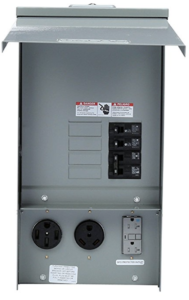
very simple wiring system. A handful of outlets and switches, low wattage microwave and refrigerator and stove (if not gas) and maybe an air conditioner which may require 220v and a 50 amp breaker. Besides that, it is a low consumption home to say the least. Most of them will have a gas stove, gas water heater and even a window unit air conditioner which uses 2-3 times less electricity than a mini-split system. It is possible for a tiny home to be run off of 110v power but not usually advisable. This can be done if the air conditioner can only be run independently or has a very small draw, such as a 5000 btu unit. There will limitations while using the microwave and hair dryer at the same time. But, there are plenty of RV’s that can be run on 110v power…which I did all the time with my 23 foot toy hauler.
If you are building a site built tiny home that is a little on the larger side (400+ square feet), it will need to wired with a higher amperage breaker box to accommodate a little more power. For example, a larger tiny house may need 50 amp service just for the air conditioner, in addition to another 50 amp breaker if you have a full size stove. Its common to have a 100-150 amp breaker panel for a tiny home that has some full size appliances. If you are wanting non-RV appliances, consider plumbing your home for gas. This will help reduce your electrical draw when powering your stove, clothes dryer and water heater, which all can use a lot of electricity. When you are designing your home, discuss with your designer which appliances you will want and how they will be powered. As mentioned earlier, your breaker panel will be wired directly to your power pole or grid connection by trenching and installing your conduit underground.
Generators for tiny homes
Most tiny homes on wheels, and even site built but off-grid homes will have an electrical plug on the outside under a weatherproof flap. This is usually a 220 volt plug to provide sufficient energy for an air conditioner, blow dryer, clothes dryer, electrical outlets and more. If this is the case, the generator will need to be at least 3000-4000 watts of power to handle the multiple loads. However, if the home is wired for 110 volts, I’ve seen 1500 watt generators able to supply enough energy for a basic tiny home. If you are running propane to heat your home (or wood burning heater/stove) and to heat your water, then your home will require a smaller generator. Remember an AC unit will be your biggest energy hog and require your generator to run nearly at the same time, depending on your inverter and battery system. Most generators will consume about a gallon per hour, and sometimes more. If you expect to run it most of the day, I would recommend adding an auxiliary fuel tank that you can connect to your generator. Tanks can be purchased for $200-300 for 100 gallon tanks.
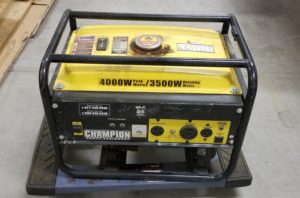
Sewer for tiny homes
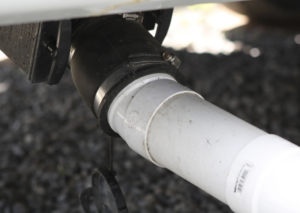
This is a fun topic as there are differences on how each type of home will be connected to the sewer. For a home on wheels, it is often an RV style with sewage drain pipes under the home that flow to a main valve. That main valve is accessible to the side of the home and can be connected by a flex pipe or PVC to the ground sewer inlet in the ground. For the more permanent home on wheels, a PVC sewer connection is more common as it requires less maintenance and will less likely be disturbed if bumped or subjected to a storm. The flex piping should be inspected often enough to make sure there is no blockage, misalignment, or change in elevation between the home and the in-ground sewer port.
For site built tiny homes, there is one main method of connecting the homes sewer with a septic tank or city sewage connection. Like a larger home, it will usually connect the toilet, shower and sink drains to a single pipe which flows directly in the the main public sewage line or septic tank. The expense usually comes to have an “underground” utility contractor to trench, pipe and connect the homes main sewer line to its destination. For a 400 sq’ home, I received a sewer line installation quote of over $2000 by itself, not including water trenching. So if your home is a good distance from your utility sources, it may get a little expensive.
Water for tiny homes
Connecting water to your new tiny home can be similar to other utilities. First, for a tiny home on wheels, there will typically be a water intake where you can attach a regular hose to on the outside. If this is the case, your water connection will be fast and easy. For more long term water connections, you will need to use PVC and attach to your home directly, with the other end being also connected by PVC to your mainline or water source. The most common PCV used for tiny home main lines are 3/4″ or sometimes 1″. The former will provide sufficient water flow, depending on your water pressure. Its also a good idea to have a pressure regulator to ensure you don’t over pressurize your homes plumbing causing a major leak. If you are connecting a water source on a site built tiny home, PVC can work just fine. In most cases it is a 1″ line if your home is plumbed with standard fixtures and not RV fixtures. This will likely cause leaks in your home if that is the case as with a home on wheels. Many well pumps are using 1″ PVC which can also convert to 3/4″ at your house if needed. Both applications for connecting water to a tiny home will need a water shut off valve in case of an emergency or the need to repair a line.
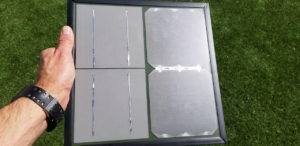
Off-grid systems for tiny homes
This is perhaps the most intriguing subject on this post for me because I’ve been in the solar business for a while and was able to get reliable information from smart people. Ill share some of this information since it came from a very talented solar and electrical engineer in addition to other resources. The tricky part about building an off grid system for a tiny houses is the electricity portion. We must first understand how much power the home will need, potentially at the same time. For example, a window air conditioning unit can require 500 to 700 watts, some refrigerators require 50 to 100 watts, a blow dryer can use over 1000 watts, small stoves over 1000 watts and so forth. So, the new power system will need to accommodate multiple draws all at the same time. So if it is hot outside and you’re running the air conditioner, and someone is using a blow dryer, and another person is cooking popcorn in the microwave, the off grid system must be able to crank out enough power for everything at the same time. For an average 400 square foot tiny home, we determined that the system would need to be between 4000-6000 watts of solar power on the roof. If the average solar panel is 285 watts each, you are looking at 21 solar panels in order to have a 6 kw system. So assuming you have space for 21 solar panels that can face in the right direction (south and southeast), you should power your home just fine…during the day. But, what will you do at night, when it’s raining or really overcast? I’ll address this in the next section! Regarding water, let’s assume you have a well, and just need the water pumped to your home by a remote switch. Most electric pumps will require 750-1250 watts to pump the water to your home, or holding tank. If you don’t have a well, then you will need it to pump from your tank (1000 gallon plus) which still requires the same electricity. Regarding an off-grid sewer system, this can for the most part use gravity to move waste from your home to your septic tank. The use of water during a toilet flush, use of the shower or sink, will allow the flow of waste to move sufficiently towards the septic tank. This type of sewage system should be reliable and require little maintenance.
Battery systems for tiny homes
Let’s assume that you have a sufficient solar system to power your house during the day. The solar system will not only need to power your electrical needs during the day, but also provide enough power to charge your batteries while it is sunny outside. This is why most solar engineers recommend more solar panels than one would expect. To charge a battery bank sufficiently, it may require more than 1000 watts of power by itself. Consider this a trickle charging approach. Your battery bank will charge slowly throughout the day from your solar panels, and be fully charged when the sun goes down. Now, the next step is to understand how much power your battery bank will need to supplyYour homes electricity needs at night. This can you get a little tricky and expensive. It is common to need $3000-$4000 in batteries and cables alone, totaling 600-800 amp hours of power.
Charge controllers and inverters
In most off-grid homes that have both solar and generator power, you will need a charge controller for each. These controllers will allow your batteries to safely charge to their capacity without overcharging and ruining your batteries. An inverter will also be necessary in order to convert DC energy to AC energy so you can use the power in your home like you would with any other home. So if you are in the market for an off-grid system, shop for the right charge controller and inverter for your home. Mismatching your electronics can cause limitations or electrical issues down the road.
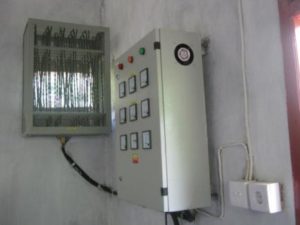
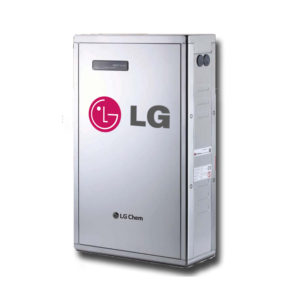
Off-grid power for tiny houses
If you were to have a 6000 kW system installed professionally, it can cost $15,000 – $18,000. Add that to a nice battery bank and the entire off-grid power system can cost well over $20,000 for a professionally installed power plant. There are a few options that can reduce the cost significantly. For example, using propane to power the stove and water heater. Also using a generator to charge your batteries each day is not a bad option if you have a large propane tank outside. The generator itself will require a very small upfront cost of less than $1000. There are a good variety of generators on the market that have a remote switch which you can click on while in your home, when needed. The biggest electrical draw at this point in your air conditioner and or heater at 500-700 watts. It will no doubt be your biggest electrical hog in the home. Homes without air conditioners require a much smaller solar system and will require less batteries. So, with that being said, if you absolutely need to have an air conditioner, it might be a good idea to power it only by your generator. That way the entire home can be powered by a smaller battery bank. Even installing a handful of solar panels to help offset your fuel use may be much less cost effective than a large system.
Off grid summary & price estimates
If you’re looking to build a very low cost off grid system for your tiny house, Here is a realistic system that may work well for a 400 square foot home:
- 2000 watts of solar $2500 if self-installed, $5,000 to $6000 if you pay a contractor.
- Battery bank with cables $3500 (self-installed)
- Generator $1000
- 500 gallon propane tank and fittings $2200
- Plastic storage shed for generator $400 (will improve lifespan)
- Misc supplies, install..etc $1000
Estimated total tiny home off-grid system $11,000 to $15,000.
Keep in mind, this off grid system will require you to fill the propane tank as needed. In most places, a service will come and fill it for you. Additionally if you do not have a well or water source, you may also need a service to come and fill up your water tank. Water hauling is very common for off grid-homes. Consider the cost of your propane and water into your monthly overhead so you know exactly what the ongoing cost will be. When people hear of off grid systems, they don’t always think about the cost of fuel and water.
When it comes down to it, I recommend connecting your home to the grid if at all possible. However, If the grid is not available in your area, consider hiring someone that will just install the entire system if you purchase the supplies and equipment. Hiring a contractor to supply everything and install an off grid system can be very expensive and take away from the fun of living off-grid.